(Written by William)
When the #21311 LEGO Ideas Voltron set was released, I was both excited and sad. I was excited because this is something from my childhood. I could recall staring longingly at the massive Voltron toy set at the store. The best I had was a smallish action figure that could pose, but didn’t transform. The sadness came from the fact that I share my LEGO hobby with my wife, and she had no frame of reference for Voltron. And, considering this is a $180 set, chances were that it wouldn’t fit in our budget. Thankfully, I was able to get a review copy, which I’m very grateful for. 🙂

The #21311 LEGO Ideas Voltron set delivers on several levels. As a Voltron toy, it’s everything I imagined the original toys from my childhood would be. It’s also a novel experience as a LEGO set, since it’s like a six-in-one with transformation properties. And, as a builder, I was drooling over all the techniques LEGO designers had to use to make this model possible. Overall, I’m very impressed, and I love the final design. It gives me all that nostalgia, along with a great building experience. The only additional feature I would have liked was micro-scale paladins to pilot the lions. Now, let’s talk about the interesting techniques found in the set!
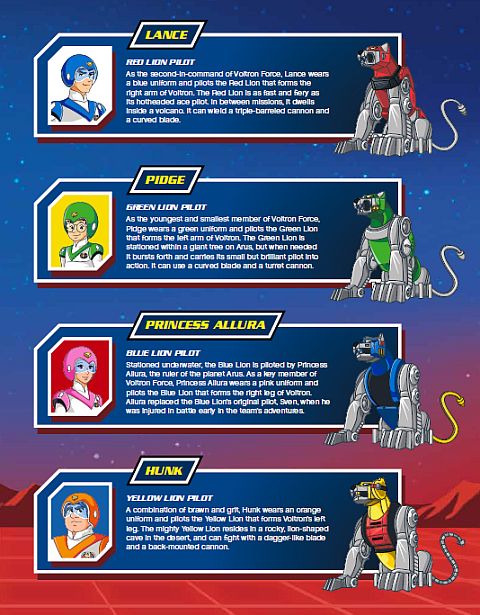
➡ BUILDING JOINTS WITH LEGO
In past segments of this Brick Breakdown series, I’ve brought to your attention a number of different ways to make joints, as techniques appeared in different sets. However, up to this point, I’ve never built a set with such a large variety of joints! All five lions have their own joints, along with the ones built for Voltron. Thus, the set gives us plenty of examples about what types of joints are good for different size models, as well as when it might be a good idea not to have a joint.
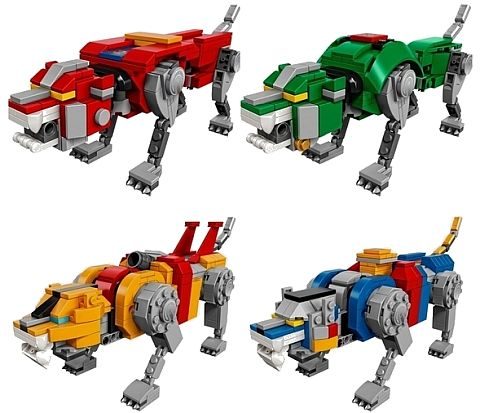
The variety comes primarily from the three sizes of lions. The red and green lions are the smallest as they make up the arms. The blue and yellow lions are a bit bigger since they form the legs. And the black lion is the largest, making up the torso of Voltron itself. With each of these size classes comes different joint types.
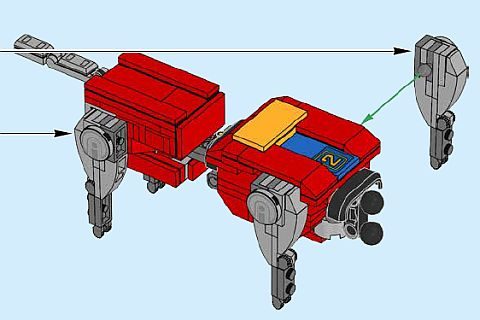
The red and green lions come with basic ball-joint connections where the legs connect to the torso, and locking finger-joints for the lower legs and paws. These are relatively small models so smaller joints are fine, however the lions also form the arms of Voltron, holding a giant sword or shield. This means larger and stronger ball-joints are needed for the elbow and wrist, which are hidden inside the mid-section and neck of the two lions. The larger ball-joints have more resistance than their smaller counterparts. Additionally, doubling up these joints makes them even tougher to move.
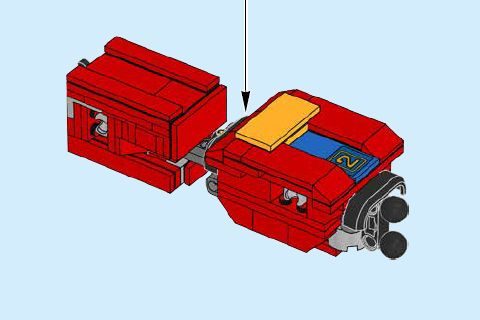
With the blue and yellow lions, we see two different techniques employed for the joints. The back legs use an axle with stud in such a way that the stud fits into a different LEGO Technic brick’s pin hole. This provides enough friction to keep the leg stiff enough to hold up the lions. Interestingly, while the front legs look similar, they use a different joint built. Inside the round section, there is a large ball-joint that provides the resistance.

As for the joints of Voltron itself, the heads of the lions used for the legs use a single axle to pivot on. Once the heads are in position, they are clipped into place. One clip is used in lion form, and two clips are used in leg form.
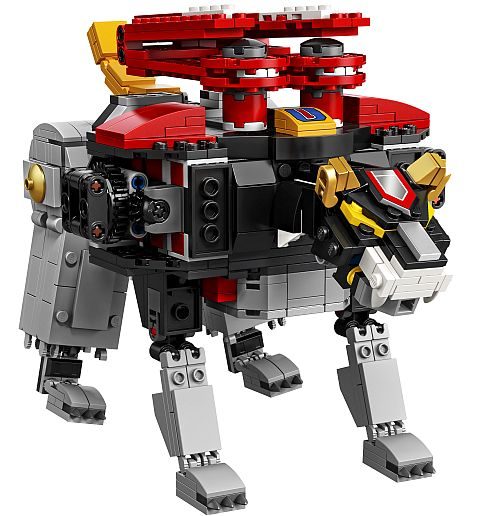
The black lion is probably the most interesting. Both the front and back legs are mostly locked in place and do not move. Only the thinner parts of the legs use either double ball-joints or double locking finger-hinges. Otherwise, they are locked in place with multiple bars and clips or LEGO Technic pins. This makes a lot of sense due to the significant weight this part of the model has to carry.

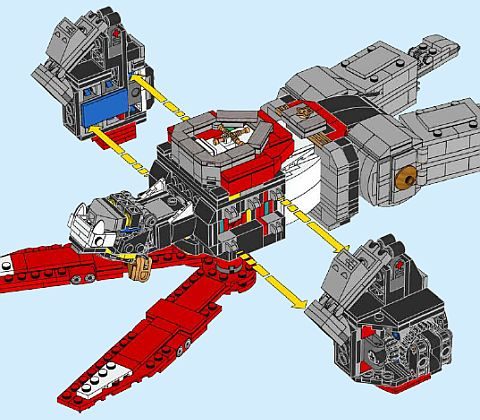
The shoulder mounts of the black lion are also worth studying. You can mount the shoulders to the lion in one of two ways, thanks to how the clips and bars connect. These are not movable joints simply because we need a specific look when Voltron is formed. Therefore, having shoulders that move independently would probably spoil that look. That’s why the actual shoulder hinges for Voltron are on the outside of the lion’s legs. This is where you have a gear-hinge connected to a smaller gear, which in turn is attached to a large ball-joint.
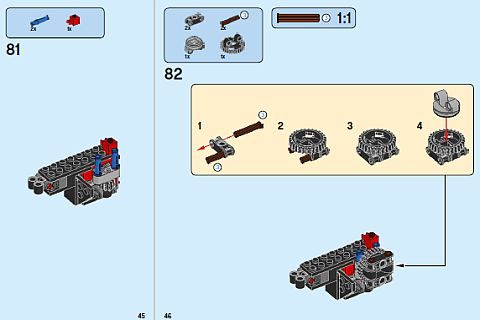
Overall, all these joints are essentially a roadmap on which joints to use given size and weight. They also are a good judge of when you shouldn’t have a moving joint. Personally, I’ve never really have been certain when it is appropriate to consider different types of joints so this model is an extremely useful example to have on hand.
➡ TRANSFORMATION WITH REBUILDING
One of the most exciting features of the #21311 LEGO Ideas Voltron set is that it can transform from five separate lions to one awesome mech. This is something we don’t normally see in LEGO sets. However, when it does happen, there are typically two schools of thought on how to approach transformation.
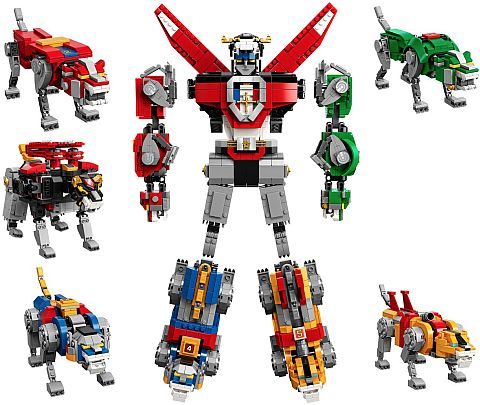
The first method is to have everything self-contained. This is where things can unfold and rotate to become something else. This is a tough way to design a LEGO model, because you need to consider where you can have negative space to hold the extra bits. Plus, there is the complex articulation involved. And, all of this needs to be counter-balanced by making sure nothing falls apart.
The second method involves partial rebuilding, which is what the #21311 LEGO Ideas Voltron set uses. Rebuilding is when you take what exists and repurpose it for something else. With this method, you have to consider maybe small elements that need to move out of the way, and two major factors; is there enough space, and can you secure the model with just the right amount of connections?
Space is simple; the smaller section you add in the rebuild needs space to exist. That’s partly why Voltron is built doing the splits. If you look closely, the legs are angled out. This is to give enough room for the yellow and blue lions, so they don’t run into each other’s space.
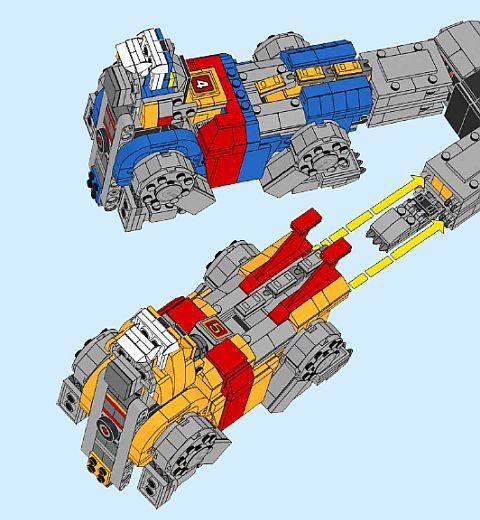
As for security, you will need to make sure your model can handle the amount of usage you plan for it. So, for example, in the #21311 LEGO Ideas Voltron set, the legs connect in with two clips and two finger-hinges. Since this is not a moving part, it only needs to hold the weight of the leg when you pick the model up. Meanwhile, the arms are connected solidly with two pins. That’s because these will be moved a lot. So, even though the arms don’t weigh as much as the legs, they end up with stronger connections.
Normally, stronger is the safer way to go when designing a LEGO model. However, in the case of transforming models, you also need to consider if it can easily come apart for transformation. It doesn’t look great if you try to remove something and end up splitting the side of your creation by ripping it apart. Therefore, only design up to whatever your needs are and try not to go beyond.
➡ BUILT-IN ACCESSORIES
Those who regularly make LEGO constraction (construction + action) figures might be used to this concept already. When you have large-scale models, you need to consider how they will handle accessories. The easiest way to do this is to allow the accessory to be built into the model.
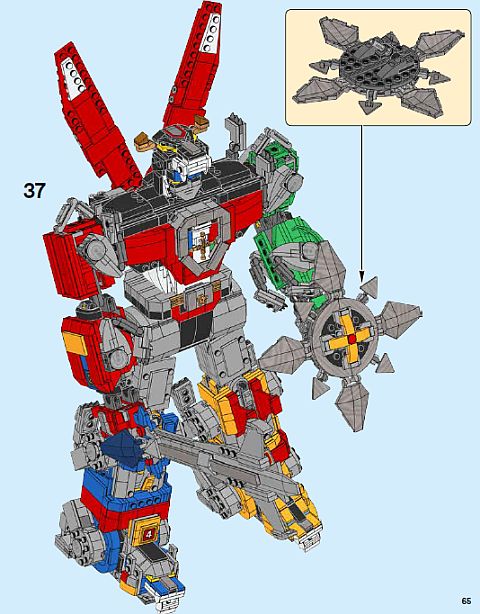
This is what we get with the sword and shield in the #21311 LEGO Ideas Voltron set. The weapons attach to the red and green lions’ mouths by pin connection. The benefit is the fact that the accessory won’t drop. That’s not to say it’s impossible to make a grasping hand, but it would take too much effort and may end up not looking very pretty.
:arrow APPLYING WHAT YOU LEARN
One big obstacle that stands in front of many builders when it comes to adding moving parts to a model has to do with joints. Most of that issue has to do with deciding what joint building technique is suitable in differing situations. The #21311 LEGO Ideas Voltron set provides some of the best examples I have seen of what to use when, ranging from minor joints to massive ones.
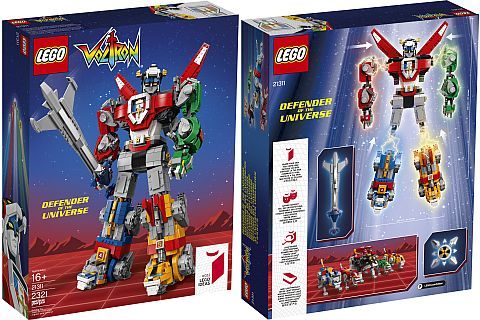
As for transformation with rebuilding, this is the method I’d recommend people to start with. Getting a sense of space and proper connections are basic skills everyone will find useful. We normally find out what limits we need to put on our designs by a trial and error method. This is the where the rebuilding technique shines, since it is extremely forgiving. I didn’t mention this, but the #21311 LEGO Ideas Voltron set does use a little bit of transformation from the first school of thought. The head and the leg lions are small examples of how a self-contained transformation can be done.

Finally, when you increase the size of a model it makes sense to build in some of the accessories that were once easily detachable. Weight increases its force when it has more leverage. Or, in simpler terms, the farther away something gets, the more it will effect what it’s attached to. By building in accessories, you can reinforce these connections and thereby limit the number of weak points. Ultimately, you’re just overcoming physics so build smarter, not harder.

What do you think? How do you like the LEGO Ideas Voltron set? Do you have it already? Have you built it yet? And what do you think of the building techniques discussed here? Are there any other interesting techniques that you noticed? Feel free to share and discuss in the comment section below! 😉
And you might also like to check out the following related posts:












I also wish they included the drivers. The joint techniques are the most interesting to me because of all the different varieties. As far as large accessories, Bionicle and other large figures remedied this by having a hand with an axle hole. It allows firm attachment but easy removal without the need to rebuild.
This set might be too big and expensive for a lot of people, but it would be great if a similar selection of joints is available in a smaller and cheaper set.
I think another technique that could be added is using color blocking. There are very few stickers in this set, and all the shaping and coloring is achieved with regular parts. I think that’s cool.
Many of the ninjago vehicles are good examples for joint building and transforming so you might want to look into those.
With Lego offering so many options for joints these days, I could see this set being a useful resource. I suppose you could just download the instructions and look through the techniques if you don’t want to spend the money.